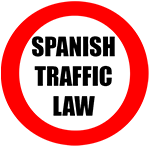1. Those who have created an obstacle or danger on the road should ensure it is cleared as soon as possible. In the meantime, necessary measures should be undertaken so that warning may be given to other users and movement not hindered.


If you drop a load you are transporting, even partially, the first thing you should do is place warning signs, so that it does not cause an accident, by using the emergency triangles and then remove the load as soon as possible.


2. Obstacles on hard shoulders and pedestrian crossings will not be considered as obstacles on the road as long as they comply with the basic regulations established for this purpose by the Ministry of Public Works and the road safety of users, in particular, cyclists.



3. Warning of the existence on the road of any obstacle or danger must be indicated effectively both day and night according to articles 103.3, 140 and 173.
Art.130.3 refers to signalling using pre-signalling warning devices.
Art. 140 determines the signage for works that must be used.
Art. 173 deals with the signs on vehicles designed to inform road users of certain circumstances or characteristics pertaining to the vehicle, of the service provided, of the load transported or of its driver. Signal V-20 (excessive loads of the vehicle)

4. All the actions that must be carried out by breakdown, medical or any other type of intervention service must be governed by principles of the use of appropriate and strictly necessary resources in each case. The autonomous body, Jefatura Centro deTráfico, or, where appropriate, the regional or local authority responsible for regulating traffic, or its agents, will agree on the presence and permanence in the area of intervention of all personnel and equipment that is essential and ensure the absence of people who are not involved in the assistance work. In addition, the Jefatura will be responsible for pointing out in each specific case the places where the emergency services vehicles or other special services must be located, including provision of the best assistance and ensuring the most appropriate help for the public.

Sometimes when a vehicle breaks down or accidents occur, relatives or friends who stop to help, park their vehicles on the hard shoulder creating more obstacles on the road and making it even more difficult for traffic. Warning signs must be placed on the road indicating that a vehicle has broken down or is damaged and awaiting assistance. Anyone other than the emergency, assistance or police services should park and wait by the side of the road.
5. The performance of teams of emergency services, as well as mechanical assistance and road maintenance, should at all times ensure the least possible impact on the rest of road users, occupying the minimum possible roadway and following at all times the instructions given by the autonomous body Jefatura Central de Tráfico or, where appropriate, the regional or local authority responsible for regulating traffic, or its agents. The behaviour of drivers and users in cases of emergency shall comply with the provisions of articles 69, 129 and 130 and, in particular, that of drivers of emergency service vehicles, as provided in articles 67, 68, 111 and 112.

As you can see, the police left one lane for the traffic whilst emergency services were working in the other lanes
6. Stopping or parking of vehicles used for the aforementioned services must be carried out in such a way that a new danger is not created and where the minimum obstacle to traffic is caused.
7. Stopping or parking in places other than those fixed by the agents of the traffic authority will be considered a serious infraction.

